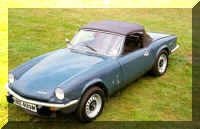Spitfire 4 (1962-1964)
Obviously it was never officially called a Mk1 as it was the first car - The biggest identifiers are the bumpers. The front bumper sits underneath the front grille. The sidelights and indicators all above the bumper. The car also has chrome trim strips running across the top seams of the front and rear wings, where they are welded to the bonnet and rear of the car. The hood is a rather complicated affair with removable struts. Rear IRS came under scrutiny for handling on the limit. The rear wheels can tuck under on lifting off, midway through a corner and cause the rear end to swing out. Not such a problem as say, on the GT6 as the car is not intended as being ultra-fast and doesn't possess that much power.
The dashboard centre is finished in black (not wooden veneer as on later models) and the dash surround is painted body-colour. (Note: The wooden steering wheel on the white car left, is non-standard)













